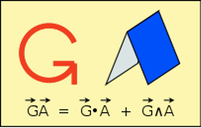Previous section: General Keplerian Motion.
Next section: The Zeroth Law of Physics.
A reference system assigns each particle a definite position with respect to a given rigid body (or reference frame). The set of all possible position vectors is a 3D Euclidean vector space called the position space of the frame.
Time dependent rigid displacement of one reference frame with respect to another is completely specified by a time dependent
Accordingly, a particle path x = x(t) in the unprimed frame is mapped into a particle path x′(t) = R(t) x(t) + a(t) in the primed frame. For this formula, we envision the unprimed frame represents the frame attached to the rigid body,which is being displaced with respect to the primed frame. Also implicit in this expression is the idea that both frames agree on a common time parameter.
When it proves convenient, we can often choose time t=0 as the time when the two frames coincide (that is, we imagine a snapshot at this time and define the primed frame to match this snapshot copy). Thus, we can take the viewpoint that the primed frame is our fixed snapshot copy of the rigid body frame as the rigid body displaces past in its travels. In such a case, we would have θ(0)=0, R(0)=1 and a(0)=0. We are considering this all taking place in a single plane, so both frames agree on the same unit bivector, i. Any particle (attached or unattached to either frame) will be seen to have a path designated by x(t) with respect to the rigid body and x′(t) with respect to the snapshot copy frame.
Problem: Suppressing the time argument and writing
derive the following equations relating velocities and accelerations in the two frames aligned at time t=0:
(Click here for solution and example.)
Newton’s 1st Law (implicitly) defines an inertial frame as a rigid body with respect to which every free particle has constant velocity.
Principle of Relativity requires that the laws of physics are the same in all inertial systems.
[First formulated by Galileo and incorporated by Newton as a corollary in his theory.]
Problem (see link below for a solution): Apply this to Newton’s 2nd Law to prove that any two inertial frames are related by
a Galilean transformation
x → x′ = Rx + c + ut where R, c and u are constant.
Derive therefrom the Galilean velocity addition theorem: v′ = v + u .
Exercise (see link below for a solution): Inside a cable car climbing a slope with constant velocity v0, an object is dropped
from rest. Derive equations for the trajectory within the car and with respect to the earth outside.
Problem: Discuss invariance of Newton’s first and second laws with respect to
Galilean time translation and scaling: t → t′ = αt + β where α and β are constant.
(Click here for solutions for these Galilean transformation problems and exercises.)
Previous section: General Keplerian Motion.
Next section: The Zeroth Law of Physics.
